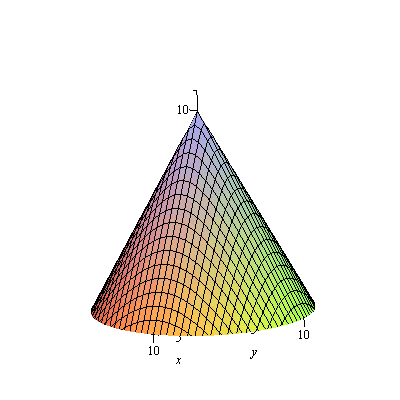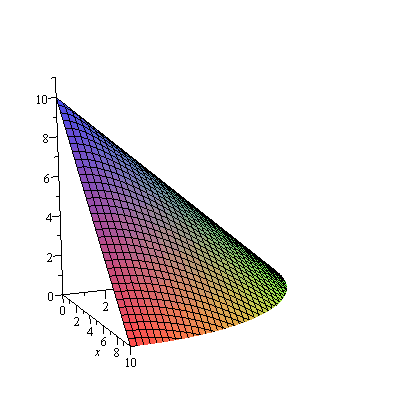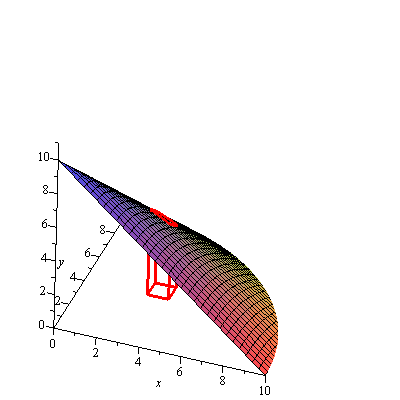| > | with(plots): |
A look (ahead) at projections and the use of cross-products. First, a nice surface:
| > | f:=(x,y)->10-sqrt(x^2+y^2); |
| (1) |
| > | fig[1]:=plot3d(f(x,y),x=-10..10,y=-10..10,axes=normal,view=[-10..10,-10..10,0..11],numpoints=1000):
fig[1]; |
 |
It's convenient to look at only the portion of this in the first octant.
| > | fig[2]:=plot3d(f(x,y),x=0..10,y=0..10,axes=normal,view=[0..10,0..10,0..11],numpoints=1000):
fig[2]; |
 |
Now suppose that we wanted to find the area of this surface; we might break it into smaller area elements that look like parallelograms, and the area of which are given by a cross-product!
| > | fig[3]:=spacecurve([3+t,4,f(3+t,4)+.1],t=0..1,color=red,thickness=3):
fig[4]:=spacecurve([3+t,5,f(3+t,5)+.1],t=0..1,color=red,thickness=3): fig[5]:=spacecurve([3,4+t,f(3,4+t)+.1],t=0..1,color=red,thickness=3): fig[6]:=spacecurve([4,4+t,f(4,4+t)+.1],t=0..1,color=red,thickness=3): display(fig[2],fig[3],fig[4],fig[5],fig[6]); |
 |
Of course, we would probably prefer to work with a parallelogram in the plane... which requires projecting the parallelogram down to the x-y plane. And projections are the desmene of the dot product.
| > | fig[7]:=spacecurve([3+t,4,0],t=0..1,color=red,thickness=3):
fig[8]:=spacecurve([3+t,5,0],t=0..1,color=red,thickness=3): fig[9]:=spacecurve([3,4+t,0],t=0..1,color=red,thickness=3): fig[10]:=spacecurve([4,4+t,0],t=0..1,color=red,thickness=3): fig[11]:=spacecurve([3,4,t],t=0..f(3,4),color=red,thickness=3): fig[12]:=spacecurve([4,4,t],t=0..f(4,4),color=red,thickness=3): fig[13]:=spacecurve([3,5,t],t=0..f(3,5),color=red,thickness=3): fig[14]:=spacecurve([4,5,t],t=0..f(4,5),color=red,thickness=3): display(fig[2],fig[3],fig[4],fig[5],fig[6],fig[7],fig[8],fig[9],fig[10],fig[11],fig[12],fig[13],fig[14]); |
 |
| > |